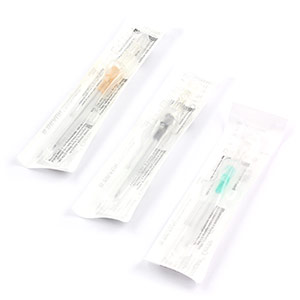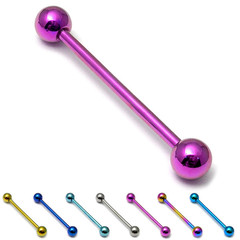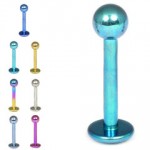We’re often asked about the pros and cons of needle piercing versus piercing with a gun. Here is some information to help you make an informed choice.
Body Piercing With a Gun
1. Piercing Guns Cannot Be Sterilised; piercing guns are usually made with plastic, and plastic cannot be sterilized in an autoclave.
An autoclave is a device used to sterilise equipment by subjecting them to high pressure saturated steam. As piercing guns cannot be adequately sterilised (an alcohol wipe is NOT sterilisation), this means that piercing guns could pass hepatitis and other diseases.
Diseases can be passed from one client to the next by cross-contamination of the piercing gun which can become contaminated when used as it forces the piercing stud jewellery through the skin. This causes blood to aerosolise (become airborne in microscopic particles) and contaminate the gun. Therefore anything that touches the contaminated gun, such as the jewellery or the piercer themselves also becomes contaminated and can possibly transmit a disease causing micro-organism.
For example; the Hepatitis virus can live for extended periods on inanimate surfaces, such as a piercing gun, and this disease can therefore be transmitted from client to client.
2. Piercing Guns Cause Tissue Trauma To Your Piercing; the whole point of a piercing gun is to force the piercing stud through your ear, thus piercing it at the same time. What this is actually doing is forcing a blunt instrument (ear stud) through your ear before piercing it. This is more like a crush injury than a piercing as the ear piercing studs are dull, so they tear through the body causing unnecessary scarring, pain and other complications.
3. Stud Jewellery Used in a Gun Is Unsuitable for Piercings; many of the ear piercing studs used in guns are the wrong size and too short for most piercings resulting in swelling, rejection, infection among other problems.
When the studs are too short they cannot accommodate the swelling that is caused by the trauma of them being forced through your skin. The lack of room to swell can cause more damage to your ear and be very painful. It is also difficult to properly clean a piercing where the jewellery is too short and this can lead to infection.
Short jewellery can limit air and blood circulation which can delay or complicate healing and cause scar tissue to form.
In addition the butterfly backing of the ear studs are made in such a design that they can easily trap dirt and bacteria which can cause infection.
Lastly, piercing studs used in guns are rarely made from Titanium or 316L Surgical Stainless Steel which are the best materials to pierce with to reduce the risk of irritation. All piercing jewellery should conform to the EC Nickel Directive, read “The EC Nickel Directive & Body Piercing Jewellery” for further information.
4. Piercing Guns Are Unsuitable for Most Piercings; the ear piercing guns used today were developed as a variation of the gun that is used to tag the ears of cattle.
Piercing guns were introduced to pierce ear lobes only but are regularly used for other piercings. Such usage is warned against by most piercing gun manufacturers and can lead to inaccurate and improper piercing placement such as off-centre and crooked piercings.
These can be difficult to heal, and can cause problems later if you decide to stretch your piercing to a different size or choose to add more holes next to your initial piercing. Crooked cartilage piercings may never heal at all, and can cause a lot of pain in the process.
5. Piercers Who Use A Gun Are Less Likely To Have Specialised Training; it can take many months and years to become a professional body piercer who has full training in anatomy, hygiene, infection control, cross-contamination prevention, sterilisation, micro-organisms and blood-borne pathogens. Alongside specialised training and practice in specific piercings and placement.
Non-professional body piercers may not have sufficient knowledge of where piercings can be placed with regard to blood vessels, veins etc. For example, piercing a tongue in the wrong place can cause a speech impediment, or even rupture a blood vessel and cause severe bleeding and a trip to hospital.
6. Piercers Who Use A Gun May Not Be Able To Provide Adequate Aftercare; Piercers that use guns are not professional body piercers and may not be able to provide you with the full and correct information on how to care for your new piercing. They may also not have sufficient knowledge to advise you if you have any problems with your piercing.
Body Piercing with a Needle
 1. Sterile Needles; each needle is sterile, single use and used only on you.
1. Sterile Needles; each needle is sterile, single use and used only on you.
2. Sterile Instruments; all instruments can be properly sterilised in an autoclave.
3. Minimal Tissue Trauma; the needle is very sharp and pushes the flesh aside (rather than a hole being forced through with the gun/jewellery) this makes needles the safest, most hygienic, least traumatic and least painful way to be pierced. This may also lead to a quicker healing time.
4. Specialised Training; professional piercers who use needles should have specific training in body piercing (as mentioned in point 5 in the piercing gun section). This means they will be able to place your piercing safely and hygienically causing the least pain.
 5. Specialised Jewellery; the jewellery used by professional piercers who use needles is specially designed for body piercing. All body jewellery must comply with the EC Nickel Directive and it is much less likely to cause a reaction. Titanium & 316L Surgical Stainless Steel body jewellery is the best choice for your initial piercing.
5. Specialised Jewellery; the jewellery used by professional piercers who use needles is specially designed for body piercing. All body jewellery must comply with the EC Nickel Directive and it is much less likely to cause a reaction. Titanium & 316L Surgical Stainless Steel body jewellery is the best choice for your initial piercing.
Specialised body jewellery, fitted in the correct size and gauge, makes it easier to clean & care for your piercing, therefore helping to reduce the healing time and the chance of infection.
6. Specialised Aftercare; professional piercers with needles will be able to advise you correctly on healing times and the appropriate care for your new piercing.
 7. Jewellery Changing; professional piercers with needles will also be able to change your jewellery, as is often required when getting a lip or tongue piercing which swell when pierced so larger size jewellery is used. Once the swelling has subsided the piercer will then change the jewellery to a smaller size appropriate to you.
7. Jewellery Changing; professional piercers with needles will also be able to change your jewellery, as is often required when getting a lip or tongue piercing which swell when pierced so larger size jewellery is used. Once the swelling has subsided the piercer will then change the jewellery to a smaller size appropriate to you.
8. Help & Advice; if you have a problem with your new piercing, a professional piercer will be able to advise & help you. Most problems with piercings are caused by the recipient not following the information provided for the cleaning and care of their new piercing.
9. Happy to Help; you should feel free to ask to see their piercing studio, and autoclave. A professional body piercer will be happy to do this and show you the sterile single use needles and answer any questions you may have regarding your piercing. You should feel completely comfortable with the piercer you choose. If any studio is not clean, or you feel that the piercer cannot answer your questions, just leave and go elsewhere.
